

128 |
4/Resolution In Propositional Logic |
This definition only allows connected rooted DAGs, but this is enough for our purpose. Indeed, DAGs arising in the resolution method are sets of DAGs as defined above.
We now describe the resolution method.
4.3.2 Definition of the Resolution Method for Propositional Logic
The resolution method rests on the fact that the proposition
((A P ) (B ¬P )) ≡ ((A P ) (B ¬P ) (A B)) |
( ) |
is a tautology. Indeed, since the above is a tautology, the set of clauses
{C1, ..., Cm, {A, P }, {B, ¬P }}
is logically equivalent to the set
{C1, ..., Cm, {A, P }, {B, ¬P }, {A, B}}
obtained by adding the clause {A, B}. Consequently, the set
{C1, ..., Cm, {A, P }, {B, ¬P }}
is unsatisfiable if and only if the set
{C1, ..., Cm, {A, P }, {B, ¬P }, {A, B}}
is unsatisfiable.
The clause {A, B} is a resolvent of the clauses {A, P } and {B, ¬P }. The resolvent of the clauses {P } and {¬P } is the empty clause 
 . The process of adding a resolvent of two clauses from a set S to S is called a resolution step. The resolution method attempts to build a sequence of sets of clauses obtained by successive resolution steps, and ending with a set containing the empty clause. When this happens, we know that the original clause is unsatisfiable, since resolution steps preserve unsatisfiability, and a set of clauses containing the empty clause is obviously unsatisfiable.
. The process of adding a resolvent of two clauses from a set S to S is called a resolution step. The resolution method attempts to build a sequence of sets of clauses obtained by successive resolution steps, and ending with a set containing the empty clause. When this happens, we know that the original clause is unsatisfiable, since resolution steps preserve unsatisfiability, and a set of clauses containing the empty clause is obviously unsatisfiable.
There are several ways of recording the resolution steps. A convenient and space-e cient way to do so is to represent a sequence of resolution steps as a DAG. First, we show that the proposition ( ) defined above is a tautology.
Lemma 4.3.1 The proposition
((A P ) (B ¬P )) ≡ ((A P ) (B ¬P ) (A B))
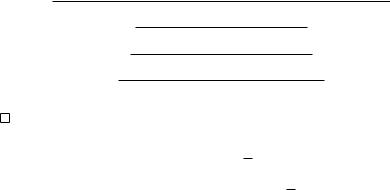
4.3 The Resolution Method for Propositional Logic |
129 |
is a tautology, even when either A or B is empty. (When A is empty, (A P ) reduces to P and (A B) to B, and similarly when B is empty. When both A and B are empty, we have the tautology (P ¬P ) ≡ (P ¬P ).)
Proof : We prove that
((A P ) (B ¬P )) ((A P ) (B ¬P ) (A B))
is valid and that
((A P ) (B ¬P ) (A B)) ((A P ) (B ¬P ))
is valid. The validity of the second proposition is immediate. For the first one, it is su cient to show that
((A P ) (B ¬P )) (A B)
is valid. We have the following proof tree (in G ):
|
|
P → P, A, B |
|
|
P, B → A, B P, ¬P → A, B |
||
A, (B ¬P ) → A, B |
P, (B ¬P ) → A, B |
|
|
(A P ), (B ¬P ) → A, B
(A P ), (B ¬P ) → (A B)
(A P ) (B ¬P ) → (A B)
→ ((A P ) (B ¬P )) (A B)
Definition 4.3.2 Given two clauses C1 and C2, a clause C is a resolvent of
C1 and C2 i , for some literal L, L C1, L C2, and
C = (C1 − {L}) (C2 − {L}).
In other words, a resolvent of two clauses is any clause obtained by striking out a literal and its conjugate, one from each, and merging the remaining literals into a single clause.
EXAMPLE 4.3.3
The clauses {A, B} and {¬A, ¬B} have the two resolvents {A, ¬A} and {B, ¬B}. The clauses {P } and {¬P } have the empty clause as their resolvent.
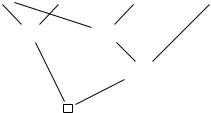
130 |
4/Resolution In Propositional Logic |
Observe that by lemma 4.3.1, any set S of clauses is logically equivalent to the set S {C} obtained by adding any resolvent of clauses in S. However, it is not true that the set
(S {C}) − {C1, C2}
obtained by adding a resolvent of two clauses C1 and C2, and deleting C1 and C2 from S is equivalent to S. If S = {{P, Q}, {¬Q}}, then {P } is a resolvent of {P, Q} and {¬Q}, but S is not equivalent to {{P }}. Indeed, the valuation v which satisfies both P and Q satisfies {{P }} but does not satisfy S since it does not satisfy {¬Q}.
We now define resolution DAGs. We believe that it is more appropriate to call resolution DAGs having the empty clause at their root resolution refutations rather than resolutions proofs, since they are used to show the unsatisfiability of a set of clauses.
Definition 4.3.3 Given a set S = {C1, ..., Cn} of clauses, a resolution DAG for S is any finite set
D = {(t1, R1), ..., (tm, Rm)}
of distinct DAGs labeled with clauses and such that:
(1) The leaf nodes of each underlying tree ti are labeled with clauses in
S.
(2) For every DAG (ti, Ri), for every non-leaf node u in ti, u has exactly two successors u1 and u2, and if u1 is labeled with a clause C1 and u2 is labeled with a clause C2 (not necessarily distinct from C1), then u is labeled with a resolvent of C1 and C2.
A resolution DAG is a resolution refutation i it consists of a single DAG (t, R) whose root is labeled with the empty clause. The nodes of a DAG which are not leaves are also called resolution steps.
EXAMPLE 4.3.4
{P, Q} |
{P, ¬Q} {¬P, Q} {¬P, ¬Q} |
{P } {Q}
{¬P }
The DAG of example 4.3.4 is a resolution refutation.

4.3 The Resolution Method for Propositional Logic |
131 |
4.3.3 Soundness of the Resolution Method
The soundness of the resolution method is given by the following lemma.
Lemma 4.3.2 If a set S of clauses has a resolution refutation DAG, then S is unsatisfiable.
Proof : Let (t1, R1) be a resolution refutation for S. The set S of clauses labeling the leaves of t1 is a subset of S.
First, we prove by induction on the number of nodes in a DAG (t, R) that the set of clauses S labeling the leaves of t is equivalent to the set of clauses labeling all nodes in t.
If t has one node, the property holds trivially. If t has more than one node, let l and r be the left subtree and right subtree of t respectively. By the induction hypothesis, the set S1 of clauses labeling the nodes of l is equivalent to the set L1 of clauses labeling the leaves of l, and the set S2 of clauses labeling the nodes of r is equivalent to the set L2 of clauses labeling the leaves of r. Let C1 and C2 be the clauses labeling the root of l and r respectively. By definition 4.3.3, the root of t is a resolvent R of C1 and C2. By lemma 4.3.1, the set S1 S2 is equivalent to the set S1 S2 {R}. But then, S1 S2 {R} is equivalent to S = L1 L2, since S1 S2 is equivalent to L1 L2. This concludes the induction proof.
Applying the above property to t1, S is equivalent to the set of clauses labeling all nodes in t1. Since the resolvent D labeling the root of t1 is the empty clause, the set S of clauses labeling the leaves of t1 is unsatisfiable, which implies that S is unsatisfiable since S is a subset of S. 
4.3.4 Converting GCN F -proofs into Resolution Refutations and Completeness
The completeness of the resolution method is proved by showing how to transform a proof in the system GCN F into a resolution refutation.
Theorem 4.3.1 There is an algorithm for constructing a resolution refutation D from a proof tree T in the system GCN F . Furthermore, the number of resolution steps in D (nonleaf nodes) is less than or equal to the number of axioms in T .
Proof : We give a construction and prove its correctness by induction on proof trees in GCN F . Let S = {C1, ..., Cm}. If the proof tree of the sequent C1, ..., Cm → is a one-node tree labeled with an axiom, there must a literal L such that some Ci = L and some Cj = L. Hence, we have the resolution refutation consisting of the DAG
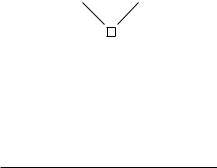
132 |
4/Resolution In Propositional Logic |
Ci Cj
This resolution DAG has one resolution step, so the base step of the induction holds.
Otherwise, the proof tree is of the form
T1 |
|
T2 |
|
Γ1, F1, ..., Fk → |
Γ2, B → |
||
Γ, {A1, B}, ..., {An, B} →
where Γ1, Γ2 Γ {{A1, B}, ..., {An, B}}, {F1, ..., Fk} {A1, ...An}, and Γ
{{A1, B}, ..., {An, B}} = S. By the induction hypothesis, there is a resolution refutation D1 obtained from the tree T1 with root Γ1, F1, ..., Fk →, and a resolution refutation D2 obtained from the tree T2 with root Γ2, B →. The leaves of D1 are labeled with clauses in Γ1 {F1, ..., Fk}, and the leaves of D2 are labeled with clauses in Γ2 {B}. Let {F1, ..., Fp} be the subset of clauses in {F1, ..., Fk} that label leaves of D1.
If {F1, ..., Fp} S, then D1 is also resolution refutation for S. Similarly, if the set of clauses labeling the leaves of D2 is a subset of S, D2 is a resolution refutation for S. In both cases, by the induction hypothesis, the number of resolution steps in D1 (resp. D2) is less than or equal to the number of leaves of T1 (resp. T2), and so, it is less than the number of leaves of T .
Otherwise, let {F1 , ..., Fq } {F1, ..., Fk} be the set of clauses not in S labeling the leaves of D1. Also, B / S and B labels some leaf of D2, since oth-
erwise the clauses labeling the leaves of D2 would be in S. Let D1 be the resolution DAG obtained from D1 by replacing F1 , ..., Fq by {F1 , B}, ..., {Fq , B},
and applying the same resolution steps in D1 as the resolution steps applied in D1. We obtain a resolution DAG that may be a resolution refutation, or in which the clause B is the label of the root node.
If D1 is a resolution refutation, we are done.
Otherwise, since B / S and D1 is not a resolution refutation, the root of D1 is labeled with B and no leaf of D1 is labeled with B. By the induction hypothesis, the number of resolution steps n1 in D1 (and D1) is less than or equal to the number of axioms in T1, and the number n2 of resolution steps in D2 is less than or equal to the number of axioms in T2. We construct a resolution refutation for a subset of Γ, {A1, B}, ..., {An, B} by combining D1 and D2 as follows: Identify the root labeled with B in D1 with the leaf labeled with B in D2, and identify all leaf nodes u, v with u D1 and v D2, i u and v are labeled with the same clause. (Since B / S, B cannot be such a clause.) The number of resolution steps in D is n1 + n2, which is less than or
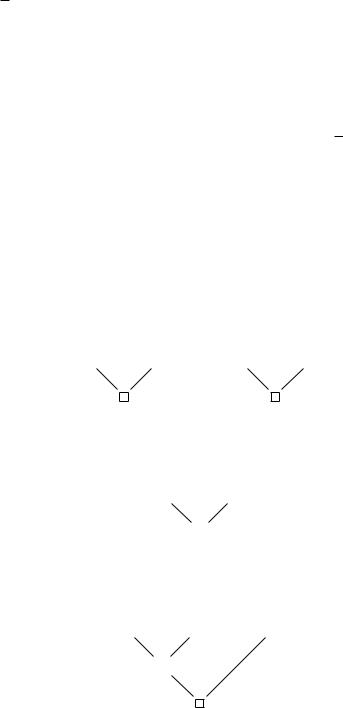
4.3 The Resolution Method for Propositional Logic |
133 |
equal to the number of axioms in T . This concludes the construction and the proof. 
Theorem 4.3.2 (Completeness of the resolution method) Given a finite set S of clauses, S is unsatisfiable if and only if there is a resolution refutation for S.
Proof : By lemma 4.3.2, if S has a resolution refutation, S is unsatisfiable. If S is unsatifiable, then the sequent S → is valid. Since the system GCN F is complete (theorem 4.2.1), there is a proof tree T for S →. Finally, by theorem 4.3.1, a resolution refutation D is obtained from T . 
EXAMPLE 4.3.5
Consider the following proof tree in GCN F :
P, ¬P → |
S, ¬S → |
|
|
|
P, S, {¬P, ¬S} → |
|
¬Q, Q → |
||
|
{P, ¬Q}, {S, ¬Q}, Q, {¬P, ¬S} → |
|
|
|
The leaves P, ¬P → and S, ¬S → are mapped into the following DAGs:
{P } |
D1 |
{S} |
D2 |
{¬P } |
{¬S} |
Let D3 be the DAG obtained from D1 by adding ¬S to {¬P }:
D3
{P } |
{¬P, ¬S} |
{¬S}
We now combine D3 and D2 to obtain D4:
D4
{P } |
{¬P, ¬S} |
{S} |
{¬S}

134 |
4/Resolution In Propositional Logic |
The leaf Q, ¬Q → is mapped into the DAG D5:
D5
{Q} {¬Q}
Let D6 be the DAG obtained from D4 by adding ¬Q to {P } and {S}:
D6
{P, ¬Q} {¬P, ¬S} {S, ¬Q}
{¬Q, ¬S}
{¬Q}
Finally, let D7 be obtained by combining D6 and D5:
D7
{P, ¬Q} {¬P, ¬S} {S, ¬Q} |
{Q} |
{¬Q, ¬S}
{¬Q}
The theorem actually provides an algorithm for constructing a resolution refutation. Since the number of resolution steps in D is less than or equal to the number of axioms in T , the number of nodes in the DAG D cannot be substantially larger than the number of nodes in T . In fact, the DAG D has at most two more nodes than the tree, as shown by the following lemma.
Lemma 4.3.3 If T is a proof tree in GCN F and T has m nodes, the number n of nodes in the DAG D given by theorem 4.3.1 is such that, r+1 ≤ n ≤ m+2, where r is the number of resolution steps in D.
Proof : Assume that T has k leaves. Since this tree is binary branching, it has m = 2k − 1 nodes. The number r of resolution steps in D is less than or equal to the number k of leaves in T . But the number n of nodes in the DAG is at least r + 1 and at most 2r + 1, since every node has at most two successors. Hence, n ≤ 2r + 1 ≤ 2k + 1 = m + 2. 

4.3 The Resolution Method for Propositional Logic |
135 |
In example 4.3.5, the number of resolution steps in the DAG is equal to the number of leaves in the tree. The following example shows that the number of resolution steps can be strictly smaller.
EXAMPLE 4.3.6
Consider the following proof tree T :
|
|
¬P, P → |
¬Q, Q → |
|
|
|
¬R, R → |
|
¬Q, ¬P, {P, Q} → |
|
|
|
|
¬R, ¬Q, {R, ¬P }, {P, Q} → |
¬R, R → |
|||||
|
¬R, ¬Q, {R, ¬P }, {P, Q, R} → |
|
|
|||
The result of recursively applying the algorithm to T yields the two DAGs D1 and D2:
D1 |
{P } |
{¬Q} |
D2 |
{¬P } |
{Q} |
corresponding to the axioms ¬P, P → and ¬Q, Q →. Adding Q to P in the DAG D1, we obtain the DAG D3:
{¬P } |
D3 |
{P, Q} |
{Q}
Identifying the root of DAG D3 with the leaf labeled Q of DAG D2, we obtain the DAG D4 corresponding to the subtree
¬P, P → ¬Q, Q →
¬Q, ¬P, {P, Q} →
of T :
{¬P } |
D4 |
{¬Q} |
{P, Q} |
{Q}
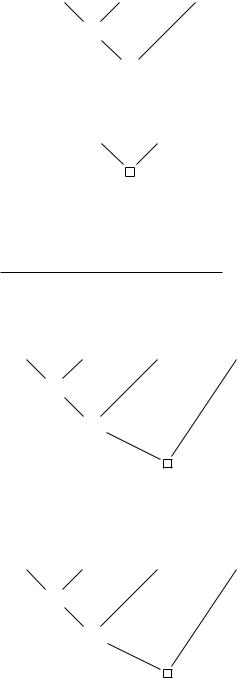
136 |
4/Resolution In Propositional Logic |
Adding R to ¬P in D4, we obtain the DAG D5:
D5 |
{¬Q} |
{R, ¬P } {P, Q} |
|
{R, Q} |
|
{R} |
|
The axiom ¬R, R → yields the DAG D6: |
|
D6 |
{R} |
{¬R} |
|
and merging the root of D5 with the leaf labeled R in D6, we obtain the DAG D7 corresponding to the left subtree
|
¬P, P → ¬Q, Q → |
|
¬R, R → |
¬Q, ¬P, {P, Q} → |
|
¬R, ¬Q, {R, ¬P }, {P, Q} →
of the original proof tree:
{R, ¬P } |
{P, Q} |
D7 |
{¬R} |
{¬Q} |
{R, Q}
{R}
At this stage, since the right subtree of the proof tree T is the axiom ¬R, R →, we add R to {P, Q} in D7. However, since R is also in {R, ¬P }, the resulting DAG D8 is a resolution refutation:
D8 |
{¬R} |
{R, ¬P } {P, Q, R} {¬Q} |
|
{R, Q} |
|
{R} |
|

4.3 The Resolution Method for Propositional Logic |
137 |
The DAG D8 has three resolution steps, and the original proof tree T has four axioms. This is because the original proof tree is not optimal. If we had applied the : rule to {¬P, R} and {P, Q, R}, we would obtain a proof tree with three axioms, which yields a DAG with three resolution steps.
4.3.5 From Resolution Refutations to GCN F -proofs
We will now prove that every resolution refutation can be transformed into a proof tree in GCN F . Unfortunately, contrary to what was claimed in the original edition of this book, the size of the resulting tree is not necessarily polynomial in the size of the DAG. This result only holds if the resolution refutation is a tree.
Theorem 4.3.3 There is an algorithm which transforms any resolution refutation D into a proof tree T in the system GCN F .
Proof : Let S = {C1, ..., Cm}. We construct the tree and prove the theorem by induction on the number of resolution steps in D. If D contains a single resolution step, D is a DAG of the form
{P } {¬P }
Hence, for some clauses Ci and Cj in the set of clauses {C1, ..., Cm}, Ci = {P } and Cj = {¬P }. Hence, the one-node tree labeled with the axiom C1, ..., Cm → is a proof tree.
If D has more than one resolution step, it is a DAG (t, R) whose root is labeled with the empty clause. The descendants n1 and n2 of the root r of (t, R) are labeled with clauses {P } and {¬P } for some propositional letter P . There are two cases: Either one of n1, n2 is a leaf, or neither is a leaf.
Case 1: Assume that n1 is a leaf, so that C1 = {P }, the other case being similar. Let
{A1, ¬P }, ..., {An, ¬P }
be the terminal nodes of all paths from the node n2, such that every node in each of these paths contains ¬P . Let D2 be the resolution DAG obtained by deleting r and n1 (as well as the edges having these nodes as source) and by deleting ¬P from every node in every path from n2 such that every node in such a path contains ¬P . The root of D2 is labeled with the empty clause. By the induction hypothesis, there is a proof tree T2 in GCN F for
